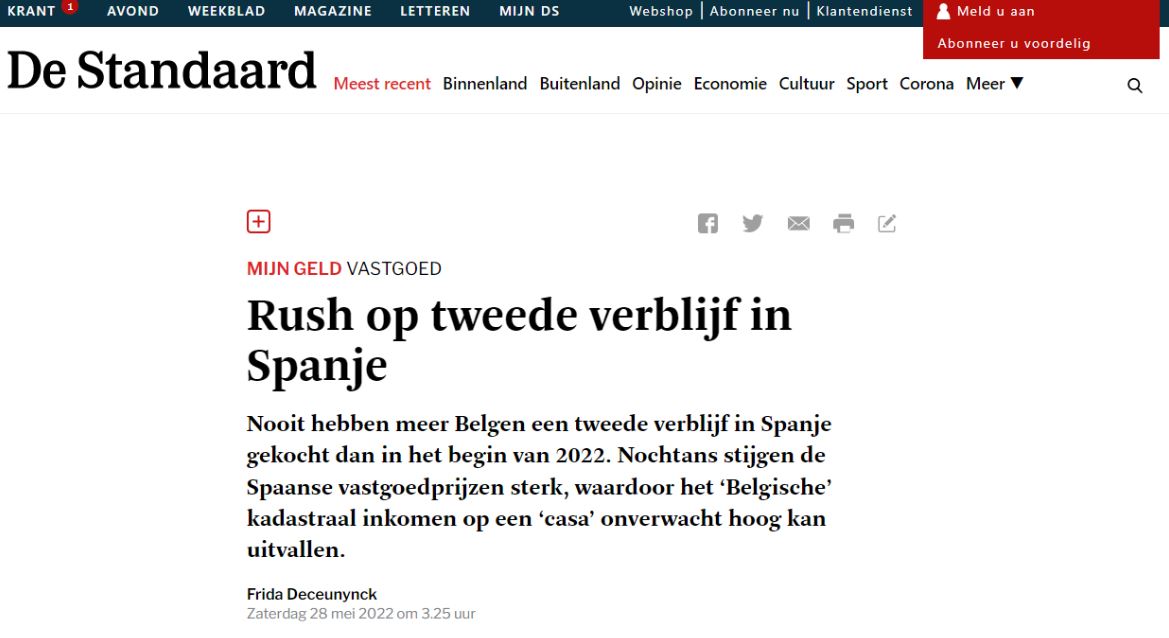More and more Belgians are buying a second residence in Spain. Since last year, the tax authorities have been sticking a Belgian cadastral income on that. Too high? Then you must respond within two months.
READ THE ARTICLE - DE STANDAARD

Second residence in Spain remains popular.
More and more Belgians are buying a second residence in Spain. Since last year, the tax authorities are sticking a Belgian cadastral income on that. Too high? Then you must respond within two months.
Belgians just can't get enough of Spanish real estate. The statistics from the Spanish registration offices do not lie. During the first quarter of this year, 1,207 Belgians bought a Spanish 'casa'. This is the highest quarterly figure ever and an increase of 23% compared to the last quarter of last year. These figures confirm the upward trend that had already begun. In 2021, 12 % more Spanish properties were sold to Belgians than in 2020.
We now receive 20% more applications than before the corona crisis. Due to low interest rates, savings hardly bring in anything anymore and people start looking for alternatives.'
Rising real estate prices in Spain
Prices are also on the rise. Spanish real estate is now 5.3% more expensive than last year. By 2021, prices were already up 7.9%. Despite rising prices, Belgians continue to beckon to Spain. This is not illogical. Compared to Belgian real estate prices, Spain is still relatively cheap. On average, a house of 100 square meters now costs almost 240,000 euros in our country compared to 190,000 euros in Spain. Moreover, the weather there is better and the lifestyle more relaxed. An additional plus is that the purchase tax in Spain is lower than in our country.'
Cadastral income for foreign properties
In Belgium, in principle, you do not have to pay tax on a Spanish property. But you do have to fill it in every year on your tax bill. By analogy with the regulation for Belgian country houses, as of this year you must declare the cadastral income (k.i.) of your foreign property. This is determined by the tax authorities based on the last known market value of your property. The new rules were implemented under pressure from Europe to eliminate the fiscal discrimination between foreign and Belgian second homes. But it is gradually becoming clear that other discriminations are taking its place.
Identical apartment, different k.i.
'Feedback from our clients shows that the cadastral incomes for identical apartments in the same building are sometimes very far apart,' says Freyke Van Looveren of New Construction in Spain/New Construction in Tenerife, one of the largest Belgian brokers active on the Spanish real estate market. 'An apartment sold on plan in 2017 at just under 500,000 euros was granted a k.i. by the tax authorities of 1,722 euros. The neighboring apartment, completely identical in terms of size, location and finish, was resold last year for 750,000 euros and on that basis was granted a cadastral income of almost 2,646 euros, 55% higher. This no longer has anything to do with the annual income the property can bring in. And suppose the apartment is resold again in a few years at a considerably higher price to a Belgian? Will the k.i. then be raised again?'
High k.i.'s
The culprit is rising real estate prices. These inflate the k.i.'s of recently purchased homes. 'An apartment with a poor location can have a higher cadastral income than a property in a prime location, just because it was purchased a few years later at a higher price,' says Carl Vorsselmans of New Construction in Spain/New Construction in Spain. 'In other files we see that the new cadastral income is up to 40% higher than the rental value that until last year could be used for the tax declaration. That was based on the Spanish valor cadastral.'
Limited impact
In practice, a high c.i. has only a limited impact on the tax you have to pay in Belgium on your property. After all, your Spanish property income is tax exempt in our country and only counts to determine the tax rate on Belgian income. Yet many owners are uncomfortable with this. 'Understandable,' believes Carl Vorsselmans. 'We see cadastral incomes of 2,000 to 3,000 euros for an apartment. In Belgium, k.i.'s of that size usually relate to large houses and villas.'
Inequality
Where does this disparity come from? 'For Belgian properties, the k.i. is determined on the basis of surface area, location, reference points in the neighborhood, etc... When the property is sold, the k.i. is transferred with it to the new buyer,' Carl Vorsselmans explains. 'For foreign properties, only the purchase value is looked at. This inequality is a thorn in the side of many of our customers. A number have already filed a notice of objection with the tax authorities to address this. Even if the immediate tax impact is limited, you never know what the k.i. granted will be used for in the future. Anyone wishing to file an appeal must be on time. This can only be done up to two months after the notification. Those who do not respond in time tacitly agree to the amount granted.'
Source: Frida Deceunynck - De Standaard